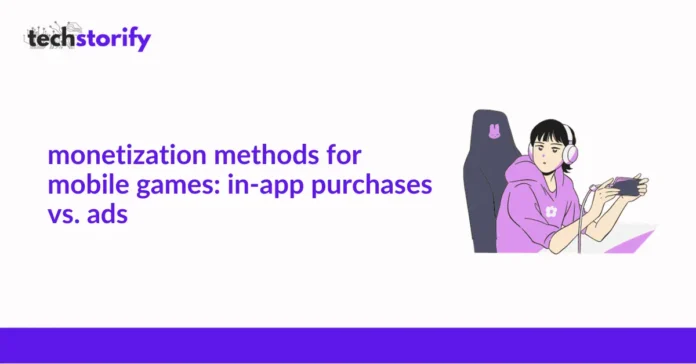In today’s digital landscape, mobile games are taking the marketplace by storm. With countless users and numerous options to choose from, the mobile video gaming industry uses a lucrative opportunity for developers. Nevertheless, the success of any mobile game lies not just in its gameplay however also in its monetization technique. For businesses seeking efficient mobile game development services, it’s crucial to comprehend the two main money making approaches: in-app purchases and advertisements. This article aims to check out these 2 avenues, assisting you choose which method is the best suitable for your video game.
Contents
Significance of Monetization in Mobile Games
Monetization is a critical consider the lifecycle of mobile game development services. It’s the engine that fuels the video game’s sustainability and long-term success. With mobile games anticipated to generate more than $120 billion in profits in 2023, comprehending monetization is more vital than ever.
In-App Purchases: The Pros and Cons
Pros
User Engagement: In-app purchases are directly linked to user engagement. Users who are purchased the video game are most likely to make a purchase to improve their experience.
- Controlled User Experience: Developers can incorporate in-app purchases seamlessly, ensuring that the user’s gaming experience is not cut off.
- Predictable Income: In-app purchases typically use a more constant income stream compared to the unforeseeable nature of advertisement revenue.
Cons
Barrier to Entry: Some users might be prevented from even downloading the video game if they perceive it as a “pay-to-win” model.
- Regulative Examination: Various jurisdictions have stringent guidelines around in-app purchases, specifically when minors are included.
- Minimal Audience: Only a little percentage of players normally make in-app purchases, restricting your revenue scope.
Advertisements: The Advantages And Disadvantages
Pros
- Mass Appeal: Ads enable income from a broader user base, even those reluctant to make in-app purchases.
- Non-Intrusive Choices: Modern mobile game development services provide non-intrusive ad formats like rewarded videos that can even enhance user engagement.
- Ease of Implementation: A lot of mobile ad networks make it relatively simple to integrate advertisements into your game.
Cons
- User Experience: Improperly placed or extremely regular ads can ruin the user experience and result in uninstalls.
- Unpredictable Income: Unlike in-app purchases, the earnings produced from advertisements can be extremely irregular.
- Reliance on 3rd Party: Your income is typically connected to the performance of the advertisement networks you utilize.
Which Strategy to Pick?
Choosing between in-app purchases and ads is a nuanced decision that often depends on several critical factors, including the nature of your game and your target audience. Casual games that attract a broad and diverse user base may find that incorporating ads is a more lucrative option. This is because casual gamers may not be as invested in the game to make frequent in-app purchases, but they are numerous enough to generate substantial ad revenue.
On the other hand, specific niche video games that deal with highly engaged and committed neighborhoods might see higher monetary returns through in-app purchases. These gamers are typically ready to spend money to boost their gaming experience, purchase unique material, or gain competitive advantages. Subsequently, the in-app purchase design could result in a more foreseeable and considerable income stream for such games.
Nevertheless, it’s also worth considering a hybrid approach that carefully combines both in-app purchases and advertisements. This strategy permits you to diversify your revenue streams and capture worth from both kinds of users: those happy to make purchases and those who choose a free-to-play design with advertisements. By tailoring the types and frequency of ads and in-app purchase choices to fit your game’s unique audience and gameplay characteristics, you can enhance both user fulfillment and earnings generation.
Conclusion
Both in-app purchases and ads come with their own set of advantages and downsides, making the option in between the two complex and highly dependent on a variety of factors. These include, however are not restricted to, your game’s target audience, genre, and the level of user engagement you’re aiming for or have actually currently achieved. The knowledge of mobile game development services can be indispensable in this context, offering you with insights and technical knowledge to tailor the most reliable money making strategy for your special needs.
Another important factor to consider is striking a balance between profits generation and user fulfillment. A lot of ads or excessively aggressive in-app purchase triggers can push away users, causing bad reviews and minimized gamer retention. On the other hand, an inadequately monetized video game, no matter how pleasurable, might fail to cover its development and maintenance expenses, eventually endangering its durability. For that reason, it’s important to discover that sweet spot where money making techniques align well with user expectations and gameplay circulation.
So, when considering monetization, it’s not almost picking in between in-app purchases and ads, but about incorporating them in a manner that feels natural and boosts the player’s experience. This is where professional mobile game development services enter play, providing data-driven options and A/B screening to fine-tune your method. In the end, the supreme goal ought to constantly be to develop a sustainable profits design while providing a high-quality, pleasurable user experience. Achieving this fragile balance is crucial to ensuring the long-lasting success and practicality of your mobile game.














